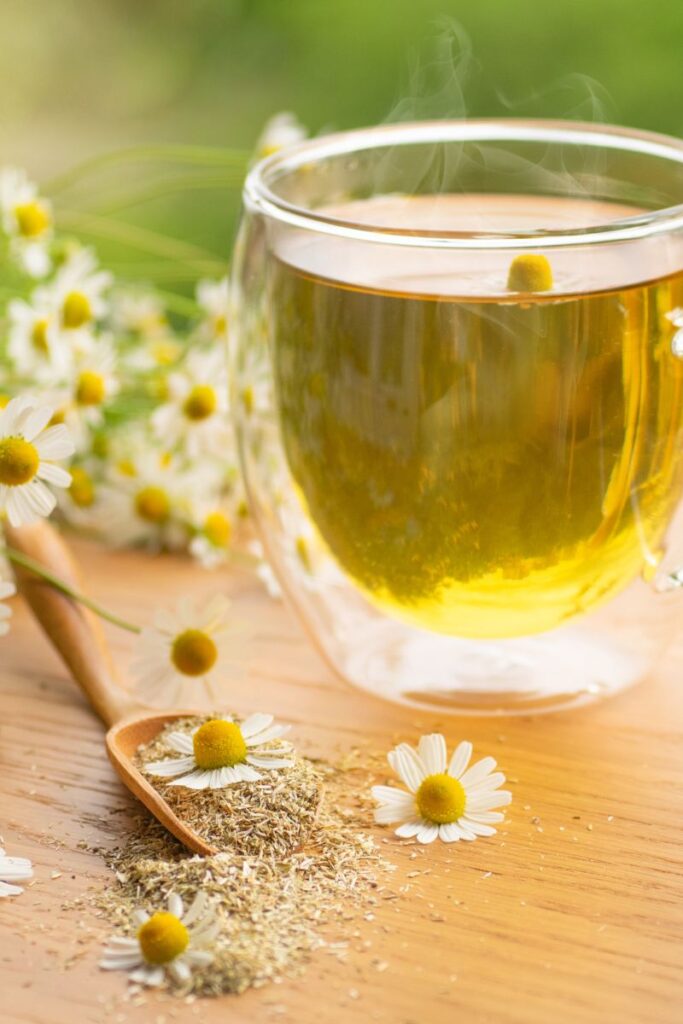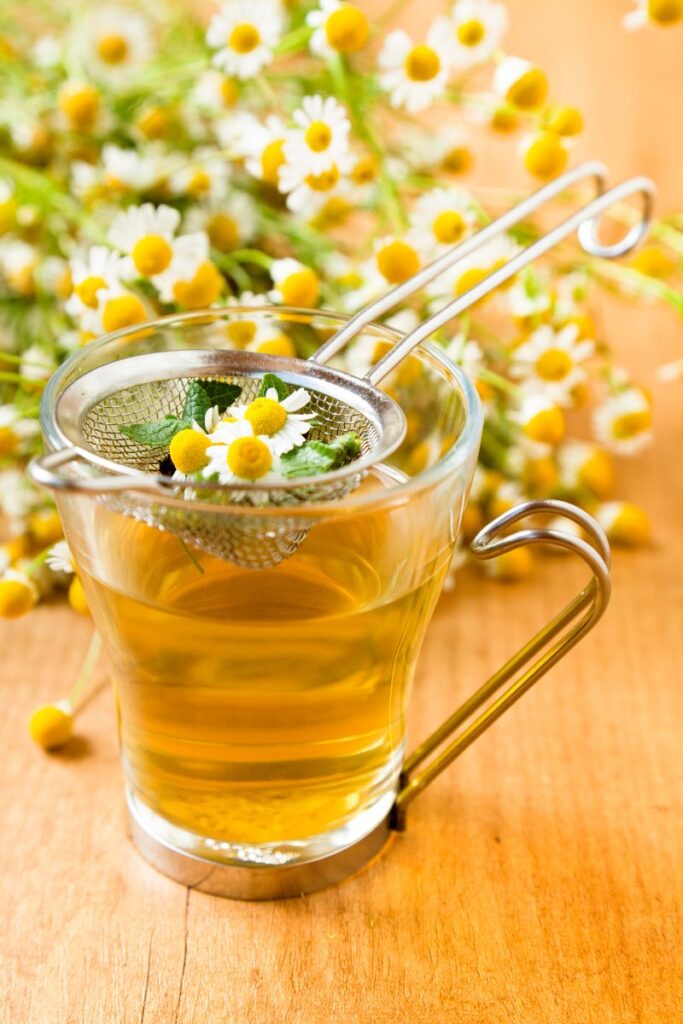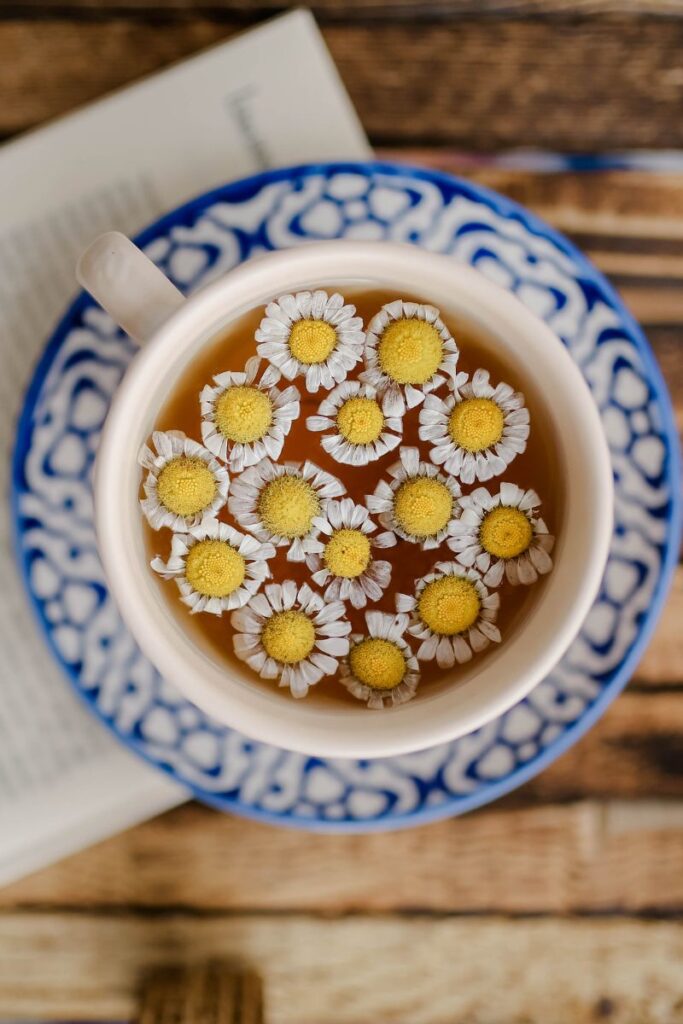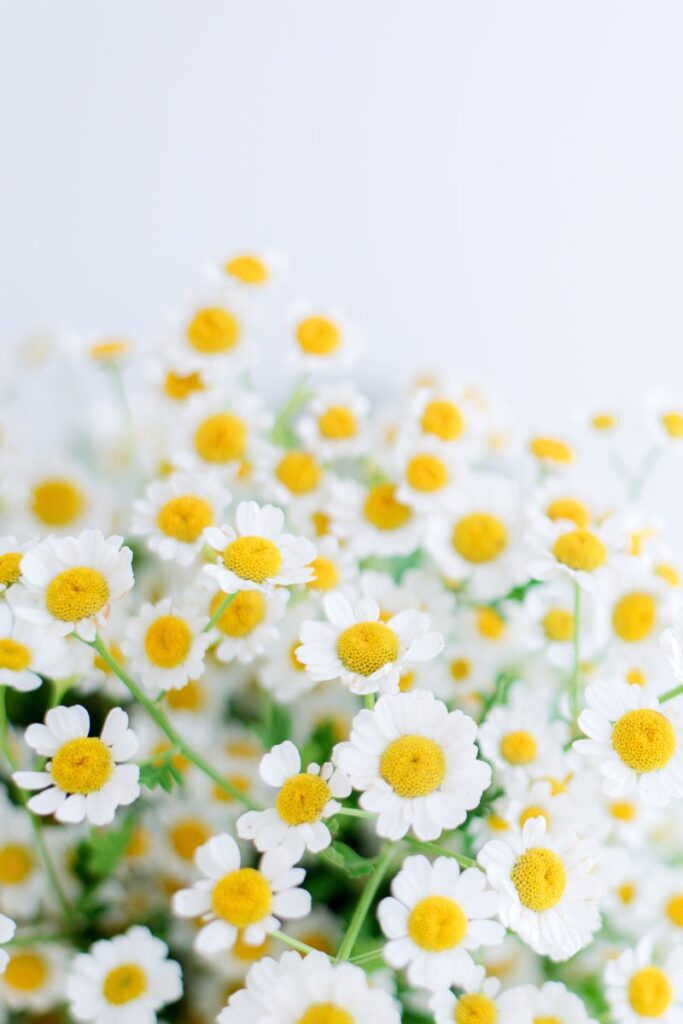Soothing Chamomile Tea for Fever, Flu, and More
When fever and flu symptoms strike, turning to natural remedies can provide much-needed relief. So, let's discuss using chamomile tea for fever and flus (along with other ways of using chamomile).

This post may include affiliate links. Please refer to our disclaimer for full disclaimer.
Using Chamomile Tea for Fever and Flu
Among the array of herbal options available, chamomile stands out as a versatile and effective herb with remarkable health benefits. Chamomile, renowned for its soothing properties, not only makes a delicious tea but also serves as a potent natural remedy for fever and flu.

In this article, we will explore the extensive health benefits of chamomile, learn how to make chamomile tea for fever and flu, discover specific herbal remedies using chamomile to combat flu symptoms, explore the calming effects of chamomile on fever, understand why chamomile is a safe and effective herb to use, and discuss any potential risks or contraindications.
Health Benefits of Chamomile
Chamomile, derived from the dried flowers of the chamomile plant (Matricaria chamomilla or Chamaemelum nobile), is a remarkable herb that has been treasured for centuries in herbal medicine for its abundant health benefits.

One of the primary reasons for chamomile's popularity is its rich antioxidant content, particularly flavonoids. These powerful antioxidants help protect the body from free radicals, unstable molecules that can cause cellular damage and contribute to various health issues. By neutralizing free radicals, chamomile's antioxidants play a crucial role in supporting overall health and boosting the immune system.
In addition to its antioxidant properties, chamomile possesses remarkable anti-inflammatory and antibacterial properties. This makes it an ideal choice for alleviating cold symptoms and combating viral infections.
The anti-inflammatory compounds in chamomile help reduce inflammation in the body, soothing irritated throat tissues and easing discomfort associated with colds and flu. Its antibacterial properties, on the other hand, can assist in fighting off harmful bacteria and supporting the body's natural defense mechanisms.

Chamomile's ability to promote relaxation and improve sleep quality is another notable health benefit. It contains a compound called apigenin, which binds to specific receptors in the brain, promoting a calming effect and reducing anxiety. By inducing a state of relaxation, chamomile can help relieve stress, which is vital for overall well-being and supporting the immune system.
Moreover, chamomile has been traditionally used to aid digestion and relieve gastrointestinal issues such as bloating, gas, and indigestion. Its soothing properties can help calm an upset stomach and alleviate discomfort, making it a popular choice for promoting digestive health.

As you can see, using chamomile tea for fever, flu, and more can be very beneficial. The versatility of chamomile and its myriad health benefits make it a valuable herb for promoting overall wellness and supporting the body's natural healing processes.
From chamomile's antioxidant power and anti-inflammatory effects to its ability to induce relaxation and aid digestion, this tea truly earns its reputation as a treasured herb in the realm of herbal medicine.
How To Make Chamomile Tea
Creating a soothing cup of chamomile tea is a simple and effective way to harness the medicinal properties of this remarkable herb. Follow these steps to prepare a comforting cup of chamomile tea:

- Boil water in a kettle or pot.
- Place 1-2 teaspoons of dried chamomile flowers in a teapot or mug.
- Pour the boiling water over the chamomile flowers.
- Cover and steep for 5-10 minutes to extract the beneficial compounds.
- Strain the tea into a cup and consider adding a squeeze of lemon juice or a teaspoon of raw honey for added flavor and health benefits.
- Sip and enjoy your warm cup of chamomile tea for fever, flu, or just relaxation.
10 Specific Herbal Remedies Using Chamomile for Fever and Flu Relief
Chamomile can be combined with other herbs to create powerful herbal remedies specifically tailored to combat fever and flu symptoms. Here are a few targeted herbal blends to try:
Chamomile Steam Inhalation
Add a few drops of chamomile essential oil to a bowl of hot water. Cover your head with a towel and inhale the steam deeply. The chamomile-infused steam can help open up the nasal passages, relieve congestion, and ease breathing difficulties associated with the flu.
Chamomile Tea with Lemon and Honey
Prepare a cup of chamomile tea and add a squeeze of fresh lemon juice and a teaspoon of raw honey. This might be the easiest way of enjoying chamomile tea for fever and flu.
Lemon provides a boost of vitamin C, while honey soothes the throat and acts as a natural cough suppressant. This combination can help alleviate flu symptoms and provide a comforting and immune-boosting beverage.
Chamomile and Peppermint Tea
Combine chamomile flowers with dried peppermint leaves to create a refreshing blend that helps alleviate flu symptoms such as a sore throat, stuffy nose, and headache. Peppermint's menthol content can provide additional relief for congestion.
Chamomile and Ginger Tea
Brew a blend of chamomile flowers and freshly grated ginger for a warming and invigorating tea that aids in boosting the immune system and easing digestive discomfort often associated with the flu.
Chamomile and Ginger Compress
Brew a strong chamomile tea and add freshly grated ginger to it. Let the mixture cool down slightly, then soak a clean cloth or towel in the liquid. Wring out the excess and place the warm compress on the forehead or chest to help reduce fever and provide relief from congestion.
Chamomile and Lemon Balm Tea
Create a calming and aromatic blend by combining chamomile flowers with lemon balm leaves. This herbal infusion promotes relaxation, providing relief from flu-induced anxiety or restlessness.
Chamomile and Licorice Root Tea
Blend chamomile flowers with licorice root tea to soothe an irritated throat. Licorice root has natural expectorant properties, which can help ease coughing and provide relief for sore muscles often experienced during the flu.
Chamomile and Marshmallow Root Tea
Combine chamomile flowers with marshmallow root to create a soothing herbal blend. Marshmallow root contains mucilage, a natural substance that coats and soothes the throat, providing relief from throat pain associated with flu symptoms.
Chamomile and Elderberry Popsicles
Brew a chamomile tea infusion and let it cool. Mix the cooled tea with elderberry syrup and pour the mixture into popsicle molds. Freeze until solid. These refreshing chamomile and elderberry popsicles can help soothe sore throats and provide hydration while delivering immune-boosting benefits.
Chamomile and Echinacea Syrup
Prepare a chamomile tea infusion and add echinacea tincture or extract to it. Mix well and sweeten with raw honey. Take a teaspoon of this herbal syrup every few hours to support the immune system and alleviate flu symptoms. Echinacea is known for its immune-boosting properties.
Try each of these remedies and see how you best enjoy chamomile tea for fever, flu, and more.

Calming Effects of Chamomile on Fever
Chamomile's calming properties make it an ideal herb to help bring down a fever and promote relaxation during illness. Here are a few ways to use chamomile for its calming effects on fever:

- Chamomile Compress: Brew a strong chamomile tea using dried chamomile flowers and let it cool. Soak a clean cloth or towel in the tea and wring out the excess liquid. Place the compress on the forehead or back of the neck to help lower body temperature and provide relief from a high fever.
- Chamomile Bath: Add a strong chamomile tea infusion to warm bathwater and soak in it for 15-20 minutes. The chamomile's soothing properties can help relax the body, ease muscle tension, and potentially reduce a high temperature.
- Chamomile Inhalation: Prepare a steam inhalation by adding a few drops of chamomile essential oil to a bowl of hot water. Cover your head with a towel and inhale the steam deeply for several minutes. This inhalation can help relieve congestion, soothe a sore throat, and promote a sense of calm during a fever.
Safety and Effectiveness of Chamomile
Chamomile is generally considered a safe herb for most individuals when consumed in moderate amounts. Its reputation as a gentle and effective herb is supported by its long history of use in traditional medicine and its popularity as a tea among millions of people worldwide.
Chamomile is well-tolerated, and side effects are rare. Using chamomile tea for fever, flu, and more is a very gentle way to support your body's immune system.

Potential Risks and Contraindications
While chamomile is generally safe, it's important to be aware of potential risks and contraindications. Some individuals may experience an allergic reaction to chamomile, especially if they have known allergies to plants in the daisy family, such as ragweed or chrysanthemums. If you have a known allergy, it's best to avoid chamomile or consult with a healthcare professional before using it.
Pregnant women should also exercise caution and consult their healthcare provider before consuming chamomile tea or using chamomile-based remedies, as chamomile has the potential to stimulate the uterus. It's always important to seek professional advice when incorporating new herbs into your health routine, particularly if you have specific health conditions or are taking medications.
Conclusion
Chamomile, with its antimicrobial, anti-inflammatory, and soothing properties, is a valuable herbal remedy for fever and flu symptoms. Whether enjoyed as a cup of chamomile tea or utilized in specific remedies to combat flu symptoms or calm a fever, chamomile offers a natural and effective way to find relief and support the body's healing process.
Embrace the healing power of nature's herbal remedies and experience the comfort and relief that chamomile can provide during times of illness.



[…] Strep throat is often accompanied by a high fever of 101 degrees Fahrenheit (38.3 degrees Celsius) or […]
[…] Unlike teas made from Camellia sinensis, herbal teas are often made from a blend of dried leaves, flowers, fruits, and herbs, which can be more delicate and susceptible to flavor degradation. When stored […]
[…] Soothing Chamomile Tea for Fever, Flu, and More […]
[…] Soothing Chamomile Tea for Fever, Flu, and More […]